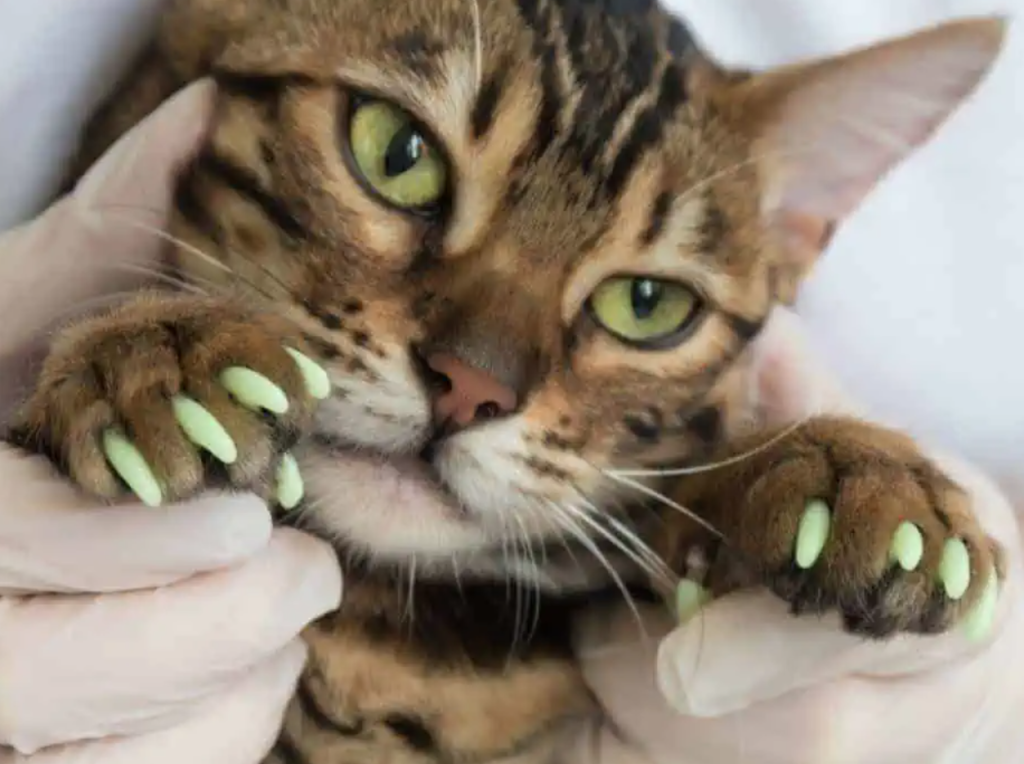I’m occasionally asked by potential kitten buyers if I allow declawing of my cats and kittens. The answer is NO and will always be absolutely NO. Declawing a cat or kitten is not minor surgery as some would like you to believe. It consists of amputating the distal toe bones by disjointing the 10 individual toes of the front feet. I mean come on people how about I remove all 10 tips of your fingers from the most distal joint?

Unlike most mammals who walk on the soles of the paws or feet, cats walk on their toes. Their back, shoulder, paw, and leg joints, muscles, tendons, ligaments and nerves are designed to support and distribute the cat’s weight across its toes as it walks, runs and climbs. A cat’s claws are used for balance, for exercising, and for stretching the muscles in their legs, back, shoulders, and paws. They stretch these muscles by digging their claws into a surface and pulling back against their own clawhold – similar to isometric exercising for humans. This is how a cat exercises, stretches and tones the muscles of its back and shoulders. The toes help the foot meet the ground at a precise angle to keep the leg, shoulder and back muscles and joints in proper alignment. Removal of the last digits of the toes drastically alters the conformation of their feet and causes the feet to meet the ground at an unnatural angle that can cause joint pain and back pain similar to that in humans caused by wearing improper shoes.
Besides being painful to excruciatingly painful for the cat, the procedure has many potential complications including damage to the radial nerve, hemorrhage, bone chips that prevent healing, painful regrowth of deformed claw inside of the paw which is not visible to the eye, and chronic back and joint pain as shoulder, leg and back muscles weaken. Beyond physical complications some cats are so shocked and emotionally damaged by declawing that their personalities change. Cats that are lively and friendly before the surgery can become withdrawn and introverted after being declawed. Others, because they are deprived of their primary means of defense, become nervous, fearful, and/or aggressive, often resorting to their only remaining means of defense, their teeth. In some cases, when declawed cats use the litter box after surgery, their feet are so tender they associate their new pain with the box…permanently, resulting in a life-long aversion to using the litter box. Other declawed cats that can no longer mark with their claws may begin to mark with urine instead resulting in inappropriate elimination problems, which in many cases, results in relinquishment of the cats to shelters and ultimately euthanasia (something not permitted by my kitten contract). Many of the cats surrendered to shelters are surrendered because of behavioral problems which developed after the cats were declawed. Many declawed cats become so traumatized by this painful mutilation that they end up spending their maladjusted lives perched on top of doors and refrigerators, out of reach of real and imaginary predators against whom they no longer have any adequate defense. A cat relies on its claws as its primary means of defense. Removing the claws makes a cat feel defenseless. The constant state of stress caused by a feeling of defenselessness may make some declawed cats more prone to disease. Stress can lead to a myriad of physical and psychological disorders including immunocompromise, chronic cystitis and irritable bowel syndrome (IBS).
So now you are probably wondering what you can do to protect your furniture from your cat. There are many good options, the best and most effective way is to take a few minutes daily to train your cat to use his or her scratching post(s). Yes, you heard me right, I said train. Cats are much more easily trained than you’ve likely been led to believe. Cats much like dogs tend to have a key reward. Once you identify what that key reward is, you’ll find that your cat will do pretty much anything you want to train it to do. Cats most often will be most likely to respond to a reward of food but some may have a toy that is the thing that absolutely drives them wild. Cats can be redirected by physically picking them up, if they start to scratch on your favorite chair, and moving them to a scratching post and offering it to them to use. When they do treat them! Appropriate negative reinforcement will work as well, keep a spray bottle of water handy and squirt them with it when they start to scratch on something that they shouldn’t. Also, make sure you have size appropriate scratching posts and furniture in different places in your home so they have an appropriate place to scratch and stretch. Depending on the size of your Maine Coon he/she may need to be able to stretch up to 4 to 5 feet tall. For a company that makes Maine Coon Sturdy Furniture with built in/on scratching posts click on this link. https://www.customqualitypetfurniture.com/
If you aren’t willing to take a few minutes a day to train your kitten or cat, you can trim their nails regularly (something that should be done anyway) so that they feel less of a need to scratch. If you start them young it just becomes part of the regular routine, just like giving them a bath. The best time to trim your cat’s claws is when she is relaxed or sleepy. Lastly, you can put on vinyl nail tips about every four to six weeks.
